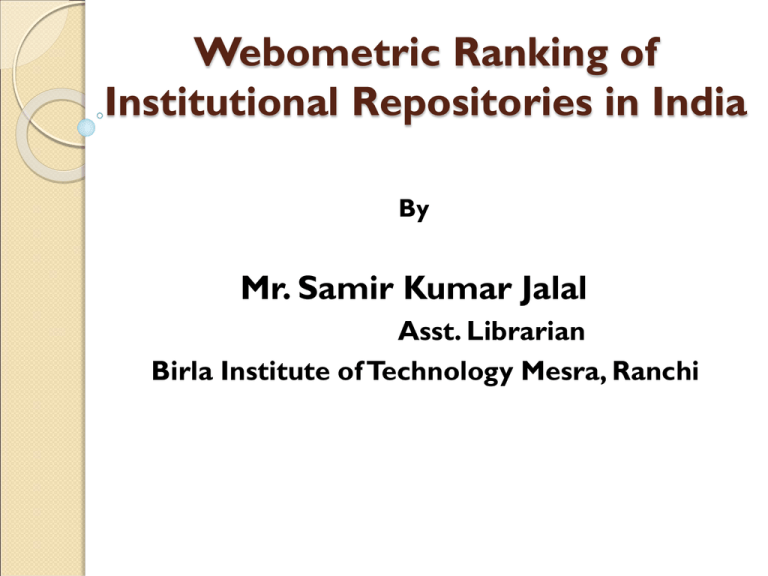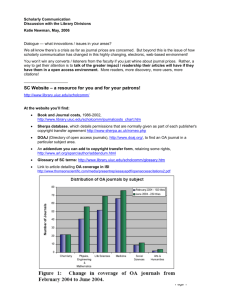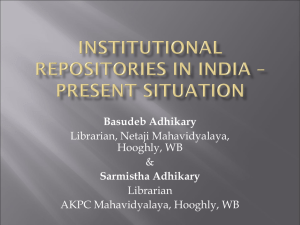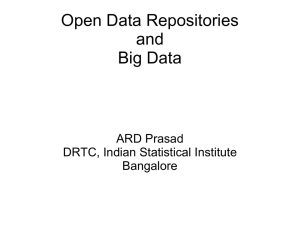Webometric Ranking of Institutional Repositories in India
advertisement

Webometric Ranking of Institutional Repositories in India By Mr. Samir Kumar Jalal Asst. Librarian Birla Institute of Technology Mesra, Ranchi Points to be Discussed Institutional Repository (IR) Need of IR Research Questions Methodology Results Conclusion Need of IR To support Open Access Initiatives; To encourage the web publication; To archive institutional knowledge and make it available through intranet; Need for Webometric Ranking To measure the global visibility and impact of scientific repositories; To know the relative position of a particular IR; To evaluate the present status of IR at the state level, national level and at the global level; Research Questions How does global visibility for institution’s scholarship measure? Is it possible to find out the web presence of Indian institutional repositories? How to develop the ranking system for Indian institutional repositories? Is it possible to know highly used software in Indian institutional repositories? Methodology Selection of Institutional Repositories Collection of URLs Selection of Search Engines Collection of Data Choice of Indicators for Ranking IR Normalization of Data Calculation of Rank Index Selection of IRs OpenDOAR: an authoritative directory of academic open access repositories. There are 52 IRs . http://www.opendoar.org/ ROAR: 73 institutional repositories in India are listed under Registry of Open Access Repository. http://roar.eprints.org Choice of Indicators Indicator SSymbol Descriptions Weights Size S Total number of webpages 20% Visibility Rich Files V R 40% 15% Scholar Sc Number of inlinks Number of rich files as measured through (.pdf,.doc,.ps,.ppt,) Google scholar during 20062010 i.e. last 5 years Number of Records Duration Ri Total number of records till September 2011 5% D It is calculated on the basis of its existence on the web 5% 15% Normalization of Data Based on each indicator, all the selected IRs are arranged in descending order of magnitude and assigned a rank for them. Calculation of Rank Index Index Value may be calculated as: 20%.S + 40%.V + 15%.R + 15%.Sc + 5%.Ri + 5%.D Where, S= Size,V= Visibility, Sc= Google Scholar, Ri= Rich Files & D= Duration Results Web presence of IRs in India Top Ten Indian IRs based on WISER Ranking Top Ten Indian IRs based on Modified WISER Top five software used in institutional repositories in India Choice of Content WISER= Web Indicators for Science Technology & Innovation (www.wiserweb.org) Top Ten IRs in India Rank Host Institute Domain IISc, Bangalore eprints.iisc.ernet.in 1 University of Mysore dspace.vidyanidhi.org.in 2 IGNOU egyankosh.ac.in 3 NISCAIR nopr.niscair.res.in 4 National Institute of Oceanography drs.nio.org 5 Indian Institute of Astrophysics prints.iiap.res.in 6 Central Marine Fisheries Research Institute eprints.cmfri.org.in NIT, Rourkela dspace.nitrkl.ac.in Bibliographic Informatics Division, NIC openmed.nic.in Thapar University dspace.thapar.edu 7 8 9 10 Top Five IR Software Rank Software 1 Dspace 2 E-Print Digital 3 Commons 4 dLibra 5 OPUS 6 Others* Total Frequency 789 326 % 46.94 19.39 86 5.12 56 55 369 1681 3.33 3.27 21.95 Conclusion To maximize the visibility of institution’s research outputs. The authors’ visibility increases if their research outputs are available through open access institutional repositories. Institutional visibility increases resulting into an increase in world rank of the institutes. IR may be at global level, institutional level and departmental level. Thank you











